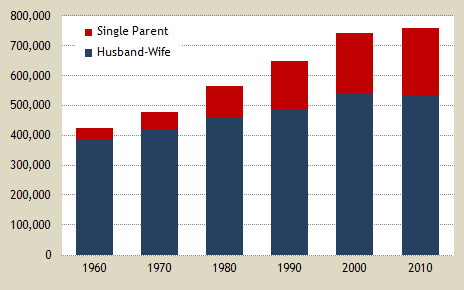In the
video "A Date With Your Family," the video's creators make the argument that having a traditionally structured nuclear family, with traditional gender roles and expectations, is the key to happiness. The video is dated to before the 1960s, when a revolution in the structure of the nuclear family began. Therefore, if we can gain a good understanding of this video and the arguments it's trying to make, we can have a greater understanding of the trajectory of the revolution of nuclear families in America. So, let's try to understand the video a little better. Together, we will examine the conjecture, definition, quality, and policy of this video, together forming what's known as the "
stasis theory."
Conjecture:
The conjecture, or facts, of this video are easily identifiable. We can see that there is a "typical" American family, consisting of all white members, two parents (a man and a woman), and three children (two boys and one girl). We can also recognize that the gender roles in the family are traditional, as the man and the boy focus on work/schoolwork, while the woman and girl focus on cooking and cleaning. These facts coincide with the expectations and values of a "typical" American family before any revolution occurred.
Definition:
The definition, or meaning/nature of the issue, can only be recognized when viewing this video in light of modern times and the revolution that occurred in the structure of the American nuclear family. "A Date With Your Family" conveys the notion that the path to happiness is a traditional family structure with traditional gender roles. Many modern families, who aren't viewed as traditionally structured, would take issue with this argument. However, the video well represents the reality of its time period, and thus we can understand the great shift that occurred not only in the nuclear family structure, but in our society as a whole.
Quality:
The quality, or seriousness of the issue, is very high in this video. Being a good representative of America's sentiments and beliefs at the time, the video reveals just how close minded and conservative American society was before the 1960s. Every family was expected to be like the family portrayed in the video, no exceptions. Many people fall under the scope of this issue; anyone living in America pre-1960s would be expected to have a family with the illustrated structure and expectations.
Policy:
The policy, or plan of action, doesn't come directly from this video but from its consequences. The direct policy of the video is that one should take action to be a member of/maintain membership in a traditionally structured nuclear family. However, from our perspective, and with our current knowledge and societal expectations, this policy can be taken oppositely in that we should be members of whatever type of family that makes us happy.
Thus, stases, or agreement on the information and conclusions of the video, is reached.
A. Jacob Shapiro

















